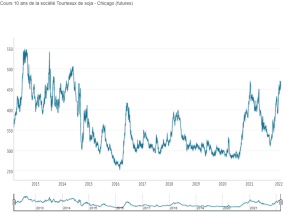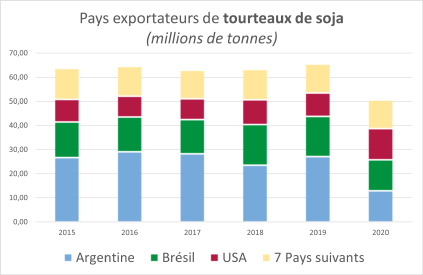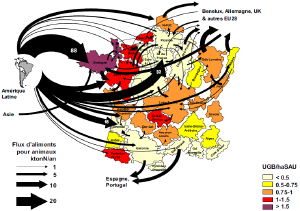Protein self-sufficiency
 Feed production, protein efficiency, economic resilience, environmental impact, agronomic considerations...
Feed production, protein efficiency, economic resilience, environmental impact, agronomic considerations...

L'protein self-sufficiency is generally defined as "the proportion of the protein requirements of one (or more) livestock units that is covered by the farm's crop production ".[1]. The aim of this introductory article is to present the main issues and avenues for development around the problem of protein autonomy.
Definition
Generally speaking, protein self-sufficiency refers to an area 's ability to meet the protein feed needs of its livestock, but the notion of area is relative : it does not necessarily refer to thefarm, as self-sufficiency can be studied on a wider scale : commune, cooperative, PDO, country, etc.[2]. Similarly, protein self-sufficiency can be studied by distinguishing between forage self-sufficiency and concentrate self-sufficiency. [3]since the latter is proportionally lower in France. [4].
Protein self-sufficiency is expressed as the percentage of self-produced feed out of the total feed consumed annually by a livestock unit, the unit most often used being TAN(Total Nitrogen Matter).
In France, the average level of protein self-sufficiency for suckler farms is around 80%, compared with 70% for dairy farms (sheep and cattle) and only 47% for goat farms.[5]. These average values conceal many disparities, and the question of increasing them is the subject of various national plans(e.g. : CAP protéines) or regional plans(e.g. : SOS - Protéines), in order to respond to a certain number ofchallenges presented below.
Issues and context
Economic issues
Economic resilience
Protein self-sufficiency, and more broadly the self-sufficiency of livestock farming, has the advantage, and often the objective, of offering a degree of economic stability.

In fact, it can reduce dependence on the purchase of protein-rich materials (materials containing at least 15% nitrogen, abbreviated MRP). This is the case, for example, with soya cake, where prices are highly variable.[1] which can double in the space of a few months.
In periods of severe economic upheaval, this price variability can be even greater, depending on the uncertainties and decisions of exporting countries. For more than a decade, just three countries have exported the vast majority of soya meal worldwide : Argentina, Brazil and the United States of America. Between 2015 and 2020, the three countries together will account for an average of 80% of global exports.

This asymmetry further increases the volatility of world prices, particularly during periods of geopolitical or economic tension, or even climatic hazards. Examples include the 1973 US embargo on its exports following an unprecedented drought.[6]or, more recently, when Argentina threatened to halt its exports in mid-March 2022 in order to raise taxes on this raw material, thereby immobilising 41% of world production[7].
Increasing the protein self-sufficiency of a state, territory or farm means that it is much less dependent on a highly fluctuating and unstable world market, which is becoming increasingly so.
However, we must be careful not to confuse autonomy with resilience. Autonomy allows us to partially free ourselves from world markets, but does not protect us from the impact of a bad year(drought, etc.). It therefore needs to be designed on a systemic basis, including storage capacity or third-party supplies in the event of a local shortfall.
Production costs
Several studies tend to prove that an increase in protein self-sufficiency (and food self-sufficiency in the broad sense) is accompanied by a reduction in feed costs.[8] [9]and sometimes even a positive impact on farm profitability.
It is estimated, for example, that in France, external protein resources account for almost 23% of the total protein consumption of the dairy herd, but 40% of feed costs. [4]. In fact, increasing protein autonomy means seeking better control of production costs, and thus being free to find an economic optimum between self-production and the purchase of feed, depending on unforeseen circumstances.
Environmental issues

Relocating protein feed for livestock is obviously part of the drive to reduce their environmental impact.
Firstly, it is recognised that feed imported in the form of oilcake (mainly soya) often comes from land freed up by deforestation (in Brazil and Argentina in particular) [10].
Secondly, importing these concentrated feeds often has the effect of breaking or disrupting local nitrogen cycles, by moving significant quantities from one continent to another [11]. In intensive livestock farming areas, which are subject to advancedeutrophication phenomena, this problem is all the more worrying because it reinforces the latter [12].

In addition, increasing a farm's protein autonomy is generally accompanied by a redesign of its cropping system. It generally incorporates a series of agro-ecological practices that enable better control of inputs, particularly fertilisers (see section #The agronomic interests of protein autonomy).
In short, increasing the protein self-sufficiency of an area or farm, through the production of local alternative proteins, helps to reduce the incentives for deforestation and a certain form of global nitrogen imbalance.
Social issues
As with environmental issues, redesigning a system to increase its protein self-sufficiency can be an opportunity to introduce practices that free up more of the farmer's time, or that incorporate new components (moving herds to pastures, etc.).
This is the case, for example, of Gaec Lusanbio in Lusanger (Pays de la Loire), a mixed farming dairy enterprise whose cropping system enables it to reconcile total food autonomy (including seeds) with anEBITDA/Gross Product ratio of 70%, and 11 weeks' holiday a year for each partner.
Some feedback has also shown that the system is more in tune with society's expectations. Some farmers are finding this an opportunity to rethink their relationship with their animals, in a bid toimprove animal welfare.
Although this is not the primary reason for the decision to move towards greater protein self-sufficiency, all these factors need to be taken into account and considered as part of a holistic approach.
Listen to a series of podcasts from the Normandy Chambers of Agriculture on the subject by clicking here.
The agronomic benefits of protein self-sufficiency
A systemic approach
At farm level, increasing protein self-sufficiency can lead to a reduction in the use of certain inputs. This is particularly the case with practices such aslengthening and diversifying rotations to break the pest cycle (incorporating forage crops, temporary grassland, grazing cover, etc.). This impact on input use is all the greater with smother crops, legumes or species that consume little nitrogen, or even more resilient combined crops (e.g. meslin).
Conversely, improving protein self-sufficiency is sometimes just one objective in a farm's overall agronomic strategy. Sometimes it is the result of a more holistic approach, aimed at multiplying sources of income, or reinforcing a production rationale : such as atmospheric carbon sequestration, integrated crop protection orsoil conservation agriculture, for example.
Our guide to protein self-sufficiency in ruminant farming
There is a wide range of levers that can be used to increase the protein self-sufficiency of a farm or region, with varying degrees of effectiveness depending on the context (technical, soil and climate, geographical, economic, etc.).
Below are a series of practical guides for each of the main families of solutions for protein autonomy :
- Autonomie en protéines
- Appréhender les besoins protéiques des ruminants
- Valoriser les prairies pour accroitre l'autonomie protéique
- Produire des cultures fourragères riches en protéines
- Produire et consommer localement des concentrés protéiques
- Transformer et stocker les ressources alimentaires protéiques
References
- ↑ 1.0 1.1 S. Pellerin, INRAE, Autonomie protéique des élevages et gestion de l'azote : quels sont les enjeux ? 2020. https://www.inrae.fr/sites/default/files/pdf/3RDF2020-Actes_DEF.pdf
- ↑ P. Brunschwig et al, IDELE, Plaquette autonomie alimentaire, 2012. http://idele.fr/fileadmin/medias/Documents/Plaquette_autonomie_alimentaire_des_troupeaux_bovins_en_France.pdf
- ↑ F. Fages et al, DicoAE, Autonomie alimentaire en concentrés et fourragères, 2016. https://dicoagroecologie.fr/encyclopedie/autonomie-alimentaire-en-concentres-et-fourragere/
- ↑ 4.0 4.1 B. Rouillé et al, L'autonomie alimentaire des élevages bovins français, IDELE, 2014. https://www.ocl-journal.org/en/index.php?option=com_article&url=/articles/ocl/full_html/2014/04/ocl140017/ocl140017.html
- ↑ O. Dupuire, Autonomie protéique des élevages, une nécessité d'avenir, Revue Paysans et Société, pages 40 to 46, 2021. https://www.cairn.info/revue-paysan-et-societe-2021-5-page-40.htm
- ↑ R. Huppert, Archives du journal Le MONDE, La pénurie de soja américain révèle l'insuffisance des sources françaises de protéines, 1973. https://www.lemonde.fr/archives/article/1973/07/06/la-penurie-de-soja-americain-revele-l-insuffisance-des-sources-francaises-de-proteines_2568252_1819218.html
- ↑ F. Cup, Buiseness Am, Argentina halts soy exports : 41% of world production comes to a halt, March 2022. https://fr.businessam.be/largentine-stoppe-ses-exportations-de-soja-41-de-la-production-mondiale-sarrete/
- ↑ C. Batthieu-Noirfalise et al, Quelles stratégies d'autonomie protéique pour quelles performances économiques et environnementales ? Study of dairy production in the Walloon Region. Centre wallon de Recherches agronomiques, 2020. https://www.cra.wallonie.be/uploads/2021/04/3r_2020_autonomie_proteique_publie.pdf
- ↑ A. Férard et al, Analyse technique et économique de l'utilisation d'enrubage ou d'ensilage de graminées et de légumineuses pour la finition des bovins, ARVALIS Institut du végétal, 2015. http://164.177.30.208/IMG/pdf/Texte__6_Alimentation_A-Ferard.pdf
- ↑ Y. Blavignat, Le Figaro Sciences, Why is France so dependent on Brazilian soya ? 2019 https://www.lefigaro.fr/sciences/pourquoi-la-france-est-elle-si-dependante-du-soja-bresilien-20190920
- ↑ J. Le Noë, et al, La place du transport de denrées agricoles dans le cycle bioogéochimique de l'azote en France : un aspect de la spécialisation des territoires. Cahiers Agricultures, EDP Sciences, 2016, 25, pp.UNSP 15004. ⟨10.1051/cagri/2016002⟩. ⟨hal-01304055⟩ https://hal.sorbonne-universite.fr/hal-01304055/
- ↑ S. Pellerin, T. Nesme, Fluxes de phosphore associés à l'élevage et conséquences sur la fertilité phosphatée des sols : analyse à plusieurs échelles, Journées AFPF La fertilité des sols dans les systèmes fourragers 8-9 Avril 2015. https://afpf-asso.fr/index.php?secured_download=2284&token=1c7eb1b12c5ed7189d725ef997c06504
